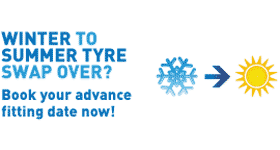Check your tyres, legal requirements
Why risk a fine and points on your driving licence, check your tyres and make sure they are legal. Being unaware of the legal requirements in the UK is no excuse in the eyes of the law. Failure to do so can lead to up to a £2500 fine and 3 penalty points per tyre.
Tyre maintenance is the responsibility of the driver, who should check their tyres ideally on a weekly basis, checking tread depth, tyre condition/damage/punctures, pressures, or signs of irregular wear.
The legal requirement in the UK regarding tread depth is 1.6mm of depth across the central ¾ of the tyre and around the whole circumference. Even though 1.6mm is the legal limit,
it is recommended that tyres are changed when they reach 3mm of depth, as there is a serious chance of aquaplaning in wet weather, as water cannot escape from the grooves fast enough at below 3mm.
The driver should also look for any signs of bulges, cracking, delamination, cuts in the tread of more that 25mm (or 10% of the tyre width), cuts that are deep enough to show any cords, or any punctures. Punctures can generally be repaired if they are in the central ¾ of the tyre tread, as long as the tyre has not been driven flat causing damage to the inner structure.
Ask your local Hometyre technician for an honest assessment; we will always repair a tyre if feasible and economical to do so.
Tyre pressures should always be corrected regularly, as under or over inflated tyres will cause uneven tyre wear, can effect handling, and increase braking distances. Checking the pressures can also be an easy way of realising that you have a puncture, if a nail or screw is not easily visible.
Irregular wear can be a sign of your tracking being out, worn bushes or in some more serious cases a suspension problem.
It is also the responsibility of the driver to ensure that any tyres that are fitted are the correct type and size for the vehicle and the purposes it is being used for. Each tyre has markings on its sidewalls giving its load ratings, speed ratings and maximum pressures it can be inflated too. (The maximum pressure shown is not the normal pressure it should be run at. Every vehicle has a pressure recommendation shown either in the door jamb, the fuel filler lid or in the owner's manual.)
You should not mix different types of tyre on your vehicle; winter tyres, commercial tyres, runflat tyres, radial or crossply tyres. Radial and crossply tyres can be fitted to the same vehicle, but should not be mixed on the same axle. I have seen some cars with a mix of winter and radial tyres, also some with a mix of radial and runflat tyres. This will greatly influence the handling of the vehicle and in case of an accident, this could be a contributing factor, and any insurance company may refuse to pay out the full claim.
Mixing brands and tread patterns of the same type of tyre is not illegal, although it is not recommended.
When it comes to spare tyres, the tyre does not have to meet legal requirements, when kept in the boot, or under the car. But once fitted it then must comply, just like any other tyre.
The table below shows how worn your tyre is as a percentage.
8mm 0% worn - Good
7mm 15% worn - Good
6mm 31% worn - Good
5mm 47% worn - Good
4mm 62% worn - Good
3mm 78% worn - Replacement recommended
2mm 94% worn - Replace urgently
1.6mm 100% worn - Legal limit reached








HometyreGroup
Join the conversation
on Twitter
Follow us